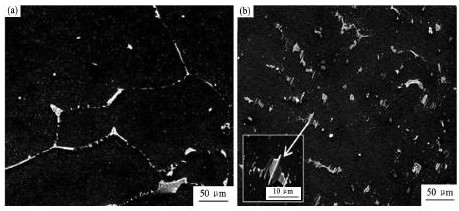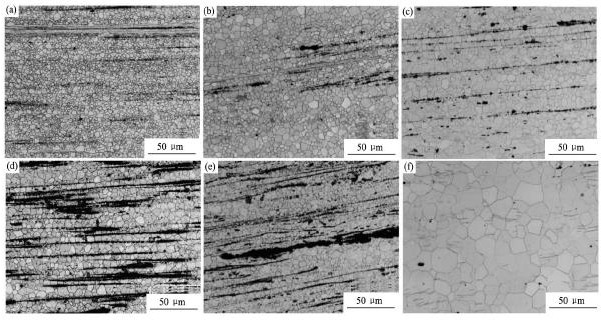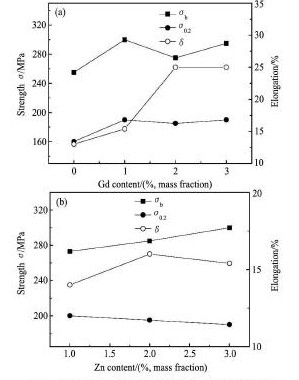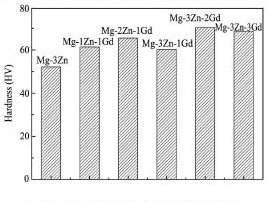网络首发时间: 2015-04-07 09:26
Mg-Zn-Gd合金的微观组织和力学性能
中南大学材料科学与工程学院
广州有色金属研究院金属成型与加工技术研究所
摘 要:
利用等离子体发射光谱仪(ICP)、光学显微镜(OM)、扫描电子显微镜(SEM)等分析手段研究了Mg-x Zn-y Gd(x=1~3,y=1~3)合金铸造态、挤压态的化学成分和微观组织演变,并测试其室温拉伸力学性能。研究结果表明:随着Gd含量的增加,铸态组织显著细化,枝状晶间距减小,其组分相Mg-Zn-Gd三元相面积分数逐渐增多,Mg Zn2相逐渐减少直至消失,第二相从晶界处呈连续网状分布转变成晶界断续和晶内均匀分布。挤压态组织得到细化,挤压过程发生了明显的动态再结晶,平均晶粒尺寸从Mg-3Zn合金的30μm降到Mg-2Zn-1Gd合金的10μm。第二相沿挤压方向趋于带状分布,部分弥散分布于晶内,成棒状或块状的Mg Zn Gd三元相,尺寸约为1~3μm。挤压态Mg-x Zn-y Gd合金的抗拉强度σb从Mg-3Zn的260 MPa提高到300 MPa,延伸率δ从13%提高到25%,屈服强度变化不大,σb和δ提高幅度分别为15.4%,92%。挤压态的显微硬度由Mg-3Zn的HV 52.1提高到Mg-3Zn-2Gd的HV 70.4,挤压态Mg-x Zn-y Gd合金室温拉伸断口呈现典型的韧性断裂特征,应力在第二相粒子处集中。
关键词:
中图分类号: TG146.22
作者简介:冯晓伟(1990-),男,山东潍坊人,硕士,研究方向:生物镁合金制备及工艺研究;E-mail:perfecthell@126.com;;戚文军,教授;电话:020-61086180;E-mail:qiwenjun987@sohu.com;
收稿日期:2014-08-21
基金:广东省中国科学院全面战略合作项目(2011A090100004);广东省科技厅产学结合创新平台建设专项(2012B090600051);广州有色金属研究院科技创新基金项目(2013A005)资助;
Microstructure and Mechanical Properties of Mg-Zn-Gd Alloys
Feng Xiaowei Qi Wenjun Li Xiaohui Li Zhicheng
College of Materials Science and Engineering,Central South University
Institute of Metal Processing and Forming Technology,Guangzhou Research Institute of Nonferrous Metals
Abstract:
The chemical composition and microstructure evolution of the cast and the extruded Mg-x Zn-y Gd( x = 1 ~ 3,y = 1 ~ 3) alloys were investigated by plasma emission spectroscopy,optical microscopy( OM),scanning electron microscopy( SEM) and other analytical tools. Tensile properties were tested at room temperature. The results showed that the as-cast microstructure was significantly refined gradually with Gd content increasing,where the space of dendrite decreased obviously. The area fraction of constituent Mg Zn Gd ternary phase gradually increased,Mg Zn2 phase was gradually reduced until disappeared,and the second phase tended to distribute from continuous reticulation along grain boundary to interrupted distributions along grain boundary and uniform distribution in the grain.The microstructure was obviously refined after extrusion,the results indicated that dynamic recrystallization occurred during extrusion,and the average grain size decreased from 30 μm for Mg-3Zn to 10 μm for Mg-2Zn-1Gd. The second phase which was rod or block MgZn Gd ternary phase with size of about 1 ~ 3 μm was zonally distributed along the extrusion direction and partly dispersed in the crystal.Compared to Mg-3Zn alloy,the tensile stress σbof Mg-x Zn-y Gd alloy increased from 260 to 300 MPa,δ increased from 13% to 25%,but there were few changes in yield strength. σband δ were accordingly increased by 15. 4% and 92%. The microhardness increased from HV 52. 1 of extruded Mg-3Zn to HV 70. 4 of extruded Mg-3Zn-2Gd. Extrusion fracture was of typical ductile fracture characteristics. The stress was concentrated at second phase particles.
Keyword:
Mg-Zn-Gd alloys; microstructure; mechanical properties; dynamic recrystallization;
Received: 2014-08-21
镁合金具有低密度、高比强度和高比刚度以及良好的阻尼性能、切削加工性、导热性等优点,是一种有广阔应用前景的轻金属合金,但较差的高温性能,特别是弱的蠕变性能和抗腐蚀性能限制了其更广泛的应用[1,2,3]。Mg-Zn系合金为常用的镁合金,具有良好的综合性能,Zn的加入明显提高合金的强度和细化晶粒。但是,沿晶界连续网状分布的Mg Zn2相降低了高温下( 120 ~ 150 ℃) 的蠕变性能,同时随着Zn含量的增加,合金的塑性会明显降低[4,5,6]。因此,改变Mg-Zn相的形态及其在晶界的分布状态是提高合金性能的重要途径。稀土元素Gd在镁中的最大固溶度为4. 53% ,且其固溶度随温度降低而下降,可实现固溶强化和时效硬化。 含Gd镁合金( 如Mg-Gd-Y[7], Mg-GdZn[8,9],Mg-Gd-Y-Zn[10]) 的力学性能和微观组织研究都取得了进展。Yu等[8]研究了微量Gd元素对高应变率轧制Mg-Zn-Zr合金的影响,结果表明:随着Gd含量的增加,晶粒明显细化,相组成发生改变,I相的含量增加,Mg7Zn3含量降低,Gd能降低Mg基体的堆垛层错能,促进轧制过程中的动态再结晶。本研究的前期工作已获得Mg-6Zn-0. 66Gd和Mg-6Zn-3. 41Gd的抗拉强度和延伸率分别为300MPa,15. 5% 和350 MPa,14. 5% ,随着Gd含量的增加,合金强度明显提高,但塑性改善有限[11]。本文通过改变Zn,Gd的含量,系统研究Mg-x Zn-y Gd合金的铸态及挤压态组织与力学性能,研究组织演变对提高塑性的影响,探索开发出中强度高塑性的镁合金,扩大镁合金在电子通信、生物医药领域的应用。
1 实验
合金锭由工业纯Mg,纯Zn和Mg-30% Gd中间合金在MRL-8 型镁合金电阻炉中熔炼而成,待纯Mg熔化后依次将纯Zn和中间合金加入熔体中,搅拌精炼后升温至750 ℃ 高温静置20 min,最后待熔体温度冷却至720 ℃后浇入圆柱型金属模具中得到铸坯,整个熔炼过程在CO2和SF6( VCO2∶ VSF6= 100∶ 1) 的保护气氛中。铸锭置于热处理炉中经420 ℃均匀化处理12 h,机加工后在638 T挤压机上进行挤压实验,挤压参数如下: 挤压比 λ 为30,挤压温度T为400 ℃,挤压速度为v为5 mm·s- 1。
经打磨和抛光后的铸态金相试样用4% ( 体积分数) 的硝酸酒精溶液腐蚀,挤压态试样用苦味酸腐蚀剂( 1. 5 g苦味酸+ 25 ml乙醇+ 5 ml乙酸+ 10ml蒸馏水) 腐蚀后再在Leica DM IRM型光学显微镜( OM) 上进行组织观察。在配有OXFORD7412 型能谱仪( EDS) 的JEOL JXA-8100 型扫描电子显微镜( SEM) 上观察组织及拉伸端口扫描。按照GBT228-2002,挤压态试样机加工成棒状标准拉伸试样,在DNS200 型万能材料实验机上进行室温拉伸实验,拉伸速度为2 mm·min- 1。
2 结果
2. 1 铸态组织
图1 和2 分别为铸态Mg-x Zn-y Gd合金的OM和SEM图。Mg-3Zn二元合金的铸态组织呈现粗大枝状晶形貌,主要由基体 α-Mg相和黑色颗粒状的Mg Zn2相组成,第二相数量较少,在晶界处富集,随着Gd含量的增加,枝状晶间距减少,晶粒逐渐细化,第二相逐渐增多,从趋于连续网状分布于晶界处转变成晶界断续和晶内均匀分布。由SEM图知,第二相形貌为颗粒状、长条状或棒状。
2. 2 挤压态组织与力学性能
图3 为Mg-x Zn-y Gd合金挤压方向上的OM图。与铸态组织相比,挤压态组织明显细化,合金在挤压过程中发生了明显的动态再结晶,组织中出现了大量细小的等轴再结晶晶粒。由图3 可知,第二相在挤压过程中破碎,沿挤压方向呈带状分布,为挤压过程形成的纤维组织。第二相周围晶粒明显细小,表明第二相的存在抑制再结晶晶粒的长大。而部分晶粒为未发生动态再结晶的原始晶粒,沿挤压方向被拉长。随着Gd含量的增加,平均晶粒尺寸从Mg-3Zn的30 μm逐渐降至Mg-2Zn-1Gd的10 μm,继续增加Gd的含量,晶粒并未得到细化。
图1 铸态Mg-Zn-Gd合金的OM图Fig. 1 OM images of as-cast Mg-Zn-Gd alloys
(a)Mg-3Zn;(b)Mg-3Zn-1Gd;(c)Mg-3Zn-2Gd;(d)Mg-3Zn-3Gd
图2铸态Mg-Zn-Gd合金的SEM图Fig.2 SEM images of as-cast Mg-Zn-Gd alloys
(a)Mg-3Zn-1Gd;(b)Mg-3Zn-3Gd
图3 挤压态Mg-x Zn-y Gd合金的OM图Fig. 3 OM images of extruded Mg-x Zn-y Gd alloys
(a)Mg-1Zn-1Gd;(b)Mg-2Zn-1Gd;(c)Mg-3Zn-1Gd;(d)Mg-2Zn-2Gd;(e)Mg-3Zn-2Gd;(f)Mg-3Zn
图4 为挤压合金的SEM图和EDS成分分析图。由图4 可知,镁合金由 α-Mg基体与Mg-Zn-Gd第二相粒子组成,第二相粒子为棒状或块状,尺寸为2 ~ 3 μm,部分沿挤压方向分布,部分弥散分布于晶内,Mg-3Zn-1Gd中Zn与Gd的原子比为1∶ 1,而在Mg-3Zn-2Gd中Zn与Gd原子比为2∶ 1。
Zn元素和稀土元素Gd对镁合金的强度和塑性的影响如图5 所示。Mg-3Zn合金的 σb,σ0. 2和 δ分别为255,160 MPa和13% ,随着稀土元素Gd的加入,Mg-x Zn-y Gd合金的抗拉强度和延伸率都得到提升,Mg-3Zn-2Gd的延伸率提高到25% ,Mg-3Zn-1Gd的抗拉强度提高到300 MPa,σb和 δ 提高幅度分别为15. 4% ,92% ,且 δ 不低于10% ,屈服强度先升高后变化不大。Mg-x Zn-1Gd合金的抗拉强度随Zn含量的增加而升高,屈服强度变化不大。
图4 挤压态Mg-3Zn-y Gd合金的SEM图和EDS谱Fig. 4SEM images and EDS spectra of extruded Mg-3Zn-y Gd alloys
(a)Mg-3Zn-1Gd;(b)Mg-3Zn-2Gd
图5 挤压态Mg-x Zn-y Gd合金室温拉伸力学性能Fig. 5Tensile mechanical properties of extruded Mg-x Zny Gd alloys
(a)Mg-3Zn-y Gd;(b)Mg-x Zn-1Gd
挤压态Mg-x Zn-y Gd合金的显微硬度如图6 所示。由图6 可知,Mg-x Zn-y Gd合金的显微硬度随着Gd的加入而不断增加,Mg-3Zn-2Gd的显微硬度达到最大为HV 70. 4,随后有所下降。Mg-Zn-Gd相的硬度高于Mg-Zn相与 α-Mg基体,所以相较于Mg-3Zn,Mg-Zn-Gd系合金的硬度显著提高。
2. 3 挤压态合金断口形貌
Mg-3Zn-2Gd和Mg-3Zn-3Gd的挤压态的拉伸断口形貌如图7 所示。挤压态合金的拉伸断口为典型的韧性断裂方式。拉伸断口由较深的韧窝组成,韧窝底部为第二相粒子,尺寸为1 ~ 3 μm,在第二相粒子周围产生应力集中,为裂纹的起始源。
3 讨论
3. 1 铸态组织
稀土元素与镁的电负性相差越小,稀土元素在镁中的固溶度越大。相反,原子间电负性相差越大,越易生成金属间化合物,生成的化合物越稳定[12]。Mg,Zn和Gd 3 种元素的电负性 χ 分别为1. 31,1. 65,1. 20[13]。可见,Zn-Gd的 Δχ 为0. 45,分别比Mg-Zn间的0. 34,Mg-Gd间的0. 11 都要大,这说明Zn与Gd间的结合力更大,因此添加的Gd优先与Zn,Mg结合并形成Mg( Zn Gd) 三元相,而在此过程中会消耗掉绝大部分Zn元素,导致Gd添加后Mg Zn2相减少。
图6 挤压态Mg-x Zn-y Gd合金的显微硬度Fig. 6 Microhardness of extruded Mg-x Zn-y Gd alloys
图7 挤压态Mg-x Zn-y Gd合金的室温拉伸断口SEM形貌Fig. 7SEM images of tensile fractures of Mg-x Zn-y Gd alloys at ambient temperature
(a)Mg-3Zn-2Gd;(b)Mg-3Zn-3Gd
Mg-Zn合金中加入稀土元素Gd的作用在图1和2 中得到明显体现。没有加入Gd时,Mg-Zn合金组织粗大,晶粒尺寸约为200 μm,加入Gd后,晶粒尺寸显著降至55 μm,而且随着Gd含量的增加,合金组织中出现含Gd的三元相,它们的分布和形态也随着Gd含量的增加而发生变化。Mg-3Zn-1Gd组织中第二相趋于连续网状分布于晶界处,Mg-3Zn-3Gd的第二相则明显增多,其第二相特征演变为晶界断续与晶内均匀分布的块状和板条状形态。这说明,Gd的加入不但使合金的晶粒得到明显细化,而且改变了第二相的形态和分布,更有利于通过组织细化和第二相强化提高合金的综合力学性能。
3. 2 挤压态组织动态再结晶分析
动态再结晶作为热加工过程中一种有效的软化和晶粒细化机制,对控制镁合金塑性变形能力以及提高材料的力学性能具有重要意义。相对于面心立方结构金属来说,镁合金更容易发生动态再结晶,这是由于镁合金为密排六方结构,滑移系非常有限,并且镁及镁合金的层错能较低,晶界扩散速度较高,使得在亚晶界上堆积的位错能够被这些晶界吸收, 从而加速动态再结晶的过程[14,15,16]。在较大挤压比( λ = 30) 下变形的镁合金,晶粒挤压破碎,产生大量位错,容易达到发生动态再结晶所需的位错密度,同时,晶界能量不断堆积,推动晶界的迁移和扩展。
在相同实验条件下( 挤压温度为400 ℃,挤压速度为5 mm·s- 1) ,再结晶晶粒大小取决于第二相颗粒的分布和大小。第二相的粒子对晶界的阻碍作用可表现为Zener阻力
根据Hall-Petch关系式,合金的屈服强度随着晶粒的细小而提高,结合图3 和图5 知,Mg-2Zn-1Gd的晶粒最为细小,其组织发生了完全再结晶,所以其屈服强度最大。然而,另一方面,再结晶过程中在晶界处存在较高的位错密度,在后续的拉伸应变中导致晶界处晶粒簇的形成,造成晶粒内部较大的内应力而诱发裂纹产生,从而使合金的延伸率降低。
4 结论
1. Mg-Zn合金中加入Gd后,铸态组织逐渐细化,Mg Zn2相逐渐消失,第二相分布形态发生变化,第二相从连续网状分布变为晶界断续和晶内均匀分布。经挤压后,第二相粒子破碎且趋于带状分布,挤压态组织得到明显细化,平均晶粒尺寸从Mg-3Zn合金的30 μm降到Mg-3Zn-1Gd合金的10 μm。
2. 挤压态Mg-3Zn-3Gd合金的拉伸力学性能σb从Mg-3Zn的260 MPa提高到300 MPa,δ 从13% 提高到25% ,屈服强度变化不大。挤压态的显微硬度由Mg-3Zn的HV 52. 1 提高到Mg-2Zn-1Gd的HV 70. 4。
3. 挤压态Mg-x Zn-y Gd合金室温拉伸断口呈现典型的韧性断裂特征,应力在第二相粒子处集中。
参考文献









